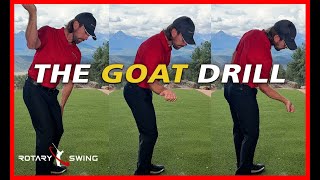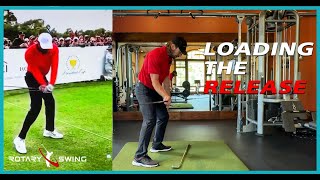Mastering the setup, weight transfer and takeaway are critical to a great golf swing. But mastering the downswing is the most important and the most challenging of all.
Because it happens so fast and requires so much precision, mastering Move 3 will be the crux of learning to become a great ball striker. Be patient with it, the rewards are many and great!
However, don't focus on the downswing until you can properly transfer your weight and perform a proper takeaway, as these key pieces set up the downswing.
This video encompasses the weight shift, the upper torso rotation, pushing vs. pulling, and much more!
Video Transcription: Golf Biomechanics - The Downswing
Move 3 is really the crux of the golf swing. Moves 1 and 2, relatively static by comparison to how dynamic the downswing is.
It's where most golfers get off. They can get everything back perfectly. The most common problem I see is their force of movement coming from the top. In other words, from up here in the shoulders.
Even if they stay in the box, still rotating that upper torso so hard that the lower body doesn't have time to shift back to the left. Your lower body doesn't move that fast. By comparison to how fast you can move the club in the arms, your hips really can't shift that fast. It's not like you can all of a sudden make a really, really quick weight shift by comparison to how fast you can throw your arms and the club from the top.
What you want to focus on during the downswing is shifting your hips back to the left. It's the number one thing you have to focus on. From the top, it's not "take your arms and shoulders and fire your club." It's "shift your weight to your left heel" - the most important move in the downswing.
If you can shift your weight to your left heel, so many things are going to fall into place for you, you won't even believe it. The catch is, nothing is happening up here during that move. Nothing with the club, arms and hands and shoulders relaxed. I'm shifting my weight to my left heel. Look where the club is.
By the time I get to here, I'm pulling with my left oblique. That pulls the club down into position. You don't have to do anything else. That's going to take care of itself.
What you have to be careful of is not getting to the top and firing from here. That's going to get you in all kinds of bad positions, which is where 90 percent of amateurs are. They're all force of movement from the top.
We want our force of movement from the top to be during the backswing. The downswing is here, shifting our weight to our left, pulling with our left oblique.
The key here is that you have to shift first. A lot of times, better golfers will get here and turn their hips really fast, but their weight's still stuck back on the right foot. They've got all problems coming from there.
First move down is shift. How is the shift done? It's not a pushing motion off the right foot. This is very, very important. A lot of golfers, when they get right here, they push off the right foot. Well, I've shifted my weight but now I've got a tremendous amount of axis tilt, or my head's in front of the ball.
I've got a big bowing out of my left leg; it's outside of neutral joint alignment, so I'm jamming my hip into the socket here and I'm stressing my lower back because I'm compressing the vertebrae in my spine.
It's not a pushing motion. There is no pushing in the golf swing. It's pulling with that left side, sitting into the left glute, then pulling with the left oblique. That's all you need to focus on in Move 3. If you start doing anything incorrectly, then we've got these things we've got to work on.
If you start pushing from the right side, we just talked about that. If you start trying to hit with the right shoulder, watch what happens to my head. It's just a natural consequence of the pushing motion; I'm going to get my head in front of the ball.
Focus on shifting first, pulling second, and the club will come down right on plane, right where you want it, every time.
Lower Body Movement in the Golf Swing
by Chuck Quinton, Founder, RotarySwing.
The movement of the lower body throughout the golf swing has been a point of serious debate for decades, and for good reason. The lateral, vertical and rotational movement of the lower body is both complex and misunderstood and too many degrees, optional! Many years ago I wanted to understand exactly how much the lower body movement contributed to clubhead speed directly. With the help from friends at the TaylorMade Performance Lab in Orlando, Florida, I was able to quantify this number exactly with some preliminary study.
My theory was that the lower body movement contributed way less than people thought and the advice that is so prevalent of “fire your hips as fast as you can from the top” to get more clubhead speed was not only bad advice, but potentially harmful as well. The legs and hips are very powerful and are capable of producing tremendous force. In the golf swing, this is traditionally thought of as rotational force since the golf swing is very rotational in nature. This powerful rotation of the hips during the downswing is capable of producing tremendous shear force on the spine, especially when there is not sufficient interabdominal pressure from proper breathing and abdominal contraction technique. This shear force is potentially very dangerous for the spine.
My testing at TaylorMade involved first quantifying the rotational speed of the hips in degrees of rotation per second and then attempting to dramatically reduce that speed and see the effects on clubhead speed. The numbers were pretty clear and simple. By reducing the rotational hip speed in half, the clubhead speed only dropped 3%. Another interesting but expected result was that the ball contact become more consistent (increased smash factor) as the hips were now in a position to provide stability and control rather than spinning wildly. While we certainly don’t want to lose clubhead speed, a drop of only 3% while reducing hip velocity by 50% and increasing the quality of contact was a significant finding. The results meant that simply firing your hips as fast as you can simply wouldn’t produce a significant boost in clubhead speed versus trying to not move them at all as we did for the test.
While these results from a small and simple test don’t provide all the answers, it provided a starting point that gave clear support to the notion that rotating the hips from the top of the swing as hard and fast as you can was both inefficient and potentially harmful. However, that doesn’t mean that you don’t want to move the hips at all because they do help produce speed and more importantly, they are a critical component of properly sequencing the downswing so that speed can be produced effortlessly. So, if we have an idea of what the hips don’t do in the downswing, what do they need to do?
During the downswing, the hips DO need to rotate but there are some parameters for this rotation. First, the hips need to rotate early in the downswing. This is key. The early rotation of the hips keeps the length of the swing in check. If the hips begin to turn back in the other direction the club simply can’t keep traveling back much further as the muscles become fully stretched. The hips beginning to move both laterally and rotationally to initiate the change of direction of the backward movement of the club will produce a shearing force of the spine as the upper torso mass is traveling in one direction while the lower body is beginning to move in the opposite direction. That’s why understanding how to stabilize the spine is critical with interabdominal pressure. This move should be used judiciously and non-violently to limit the stress on the spine. If the transition is done smoothly, the forces on the spine will be very low. If a golfer already has back troubles, they should avoid this move all together.
The hips begin their activity as a breaking mechnanism to halt the backward momentum creating during the backswing. As they decelerate the upper torso, they first begin by shifting back toward the target side leg. This transfer of mass is critical to generate momentum. Momentum is a critical piece of the golf swing as it’s needed to move a large mass like the upper torso in a new direction in a controlled manner. Control is the key word here. The initial downswing sequencing needs to be governed and under control rather than some violent move. The movement of the large pelvic structure via the weight transfer serves as an excellent mechanism that can be used to create this momentum and control the change of direction of the swing.
This movement doesn’t happen magically. It happens via muscular activation just like any other movement in the golf swing. There are numerous muscles involved to shift the weight back to the target side leg, some primary and many secondary. But there is one often overlooked force that helps the weight shift perhaps more than any other – gravity. During the transition, the golfer should be actively beginning to load the lead leg by placing the primary muscles – glutes, quadriceps, hamstring and gastrocnemius – under dynamic tension. Why place them under load? Because they are the first muscles to move in the downswing so they can’t be asleep during the brief backswing and then be expected to spring to life all of a sudden in less than a tenth of a second. So, then the question is how do we load them?
During the backswing, the weight is balanced dynamically over the angled right leg. Angled being the key word here. The right leg is angled toward the target such that if the left leg were to be instantly removed at the top of the backswing the golfer would fall over toward the target. If the golfer were to move his center of mass far enough to the right such that he could remain balanced over the right leg completely, the head would have to shift significantly away from the target during the backswing. Because this is undesirable for numerous reasons, the head remains fairly centered throughout the swing meaning that the right leg retains its angle established at address and even increases as the backswing nears its end due to the rotation of the hips. Because the hips are tilted at an angle at address, as the hips rotate during the backswing, the left hip becomes lower than the right and the knee flex increases in the lead leg. If the golfer didn’t have any muscular tension on the lead leg, he’d simply collapse toward the target – which is an oversimplified way of explaining how gravity is a major influencing factor to help shift the weight back to the target leg.
By allowing the weight to “fall” more onto the lead leg during the transition, the knee flex increases even slightly more placing the lead leg under even more tension, preparing it to spring into action. This fall moves the majority of the weight to the lead leg.
Watch part 2 now to see how you're moving your body in the opposite direction of the pros!
































































































































































































































































































































































































































































































